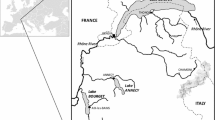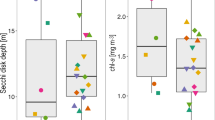Abstract
The hypothesis that climate changes may strongly interfere with the peculiar hydrological patterns in the Mediterranean basin and alter the structure of the aquatic biota was tested in a shallow Sicilian lake. A phytoplankton survey, carried out monthly in the brackish and shallow Biviere di Gela, in 2005–2007, revealed a transformation in the structure of its phytoplankton assemblage as compared with similar data collected in 1987–1988. An analysis of the trends followed by precipitation and temperature over the last 40 years, showed reduced water inflows, due to increased air temperature and evapotranspiration rather than to a decrease in the amount of precipitation. A consequent reduction in water level occurred, which almost caused the disappearing of the lake at the beginning of the century. This reduction in water level disrupted the littoral zone of the lake and transformed it from a clear, macrophyte-dominated environment to a turbid one characterized by huge summer blooms of the cyanobacteria Aphanizomenon ovalisporum, Cylindrospermopsis raciborskii, and Pseudanabaena limnetica. The addition of freshwater from a nearby dam reservoir, to restore water levels, likely opened the way to another alga, Prymnesium parvum, whose allelopathic and toxic glycosides further contributed to the transformation of the lake biota. On the whole, the Biviere di Gela is an example of how climate changes, coupled with inadequate management procedures, may negatively impact Mediterranean aquatic ecosystems.






Similar content being viewed by others
References
Barone, R., R. Termine & B. Massa, 2008. Note su un bloom di Prymnesium parvum (Haptophyta) nel lago di Pergusa e sue conseguenze sulla fauna. Il Naturalista Siciliano 32: 187–200.
Beklioglu, M., G. Altınayar & C. O. Tan, 2006. Water level control over submerged macrophyte development in five shallow lakes of Mediterranean Turkey. Archiv für Hydrobiologie 166: 535–556.
Calvo, S., R. Barone, L. Naselli-Flores, C. Orestano, A. Lugaro, G. Dongarrà & G. Genchi, 1993. Limnological investigations on lakes and reservoirs in Sicily. Il Naturalista Siciliano 17(Suppl.): 1–292.
Codd, G. A., L. F. Morrison & J. S. Metcalf, 2005. Cyanobacterial toxins: risk management for health protection. Toxicology and Applied Pharmacolology 203: 264–272.
De Martonne, E., 1926. Une nouvelle function climatologique: L’indice d’ariditè. Meterologie 2: 449–459.
Gkelis, S., M. Moustaka-Gouni, K. Sivonen & T. Lanaras, 2005. First report of the cyanobacterium Aphanizomenon ovalisporum Forti in two Greek lakes and cyanotoxin occurrence. Journal of Plankton Research 27: 1295–1300.
Granéli, E. & N. Johansson, 2003. Increase in the production of allelopathic substances by Prymnesium parvum cells grown under N- or P-deficient conditions. Harmful Algae 2: 135–145.
Hammer, O., D. A. T. Harper & P. D. Ryan, 2001. Past: paleontological statistics software package for education and data analysis. Palaeontologia Electronica 4: 4–9.
Harman, J. G. & J. P. Grover, 2008. Mixotrophy and the persistence of Prymnesium parvum when in competition with bacteria. Proceedings of the International Association of Theoretical and Applied Limnology 30: 231–234.
Hillebrand, H., C.-D. Dûrselen, D. Kirschtel, U. Pollingher & T. Zohary, 1999. Biovolume calculation for pelagic and benthic microalgae. Journal of Phycology 35: 403–424.
Igarashi, T., M. Satake & T. Yasumoto, 1999. Structures and partial stereochemical assignments for prymnesin-1and prymnesin-2: potent hemolytic and ichthyotoxic glycosides isolated from the red tide alga Prymnesium parvum. Journal of the American Chemical Society 121: 8499–8511.
Jones, P. D. & M. E. Mann, 2004. Climate over past millennia. Reviews of Geophysics 42: RG2002. doi:10.1029/2003RG000143.
Kruskal, J. B. & M. Wish, 1978. Multidimensional scaling. Sage Publications, London: 96 pp.
Luterbacher, J., E. Xoplaki, C. Casty, H. Wanner, A. Pauling, M. Küttel, T. Rutishauser, S. Brönnimann, E. Fischer, D. Fleitmann, F. J. González-Rouco, R. García-Herrera, M. Barriendos, F. Rodrigo, J. C. Gonzalez-Hidalgo, M. A. Saz, L. Gimeno, P. Ribera, M. Brunet, H. Paeth, N. Rimbu, T. Felis, J. Jacobeit, A. Dünkeloh, E. Zorita, J. Guiot, M. Türkes, M. J. Alcoforado, R. Trigo, D. Wheeler, S. Tett, M. E. Mann, R. Touchan, D. T. Shindell, S. Silenzi, P. Montagna, D. Camuffo, A. Mariotti, T. Nanni, M. Brunetti, M. Maugeri, C. Zerefos, S. De Zolt & P. Lionello, 2006. Mediterranean climate variability over the last centuries: a review. In Lionello, P., P. Malanotte-Rizzoli & R. Boscolo (eds), The Mediterranean Climate: an Overview of the Main Characteristics and Issues. Elsevier, Amsterdam: 438 pp.
Legrand, C., K. Rengefors, G. O. Fistarol & E. Granéli, 2003. Allelopathy in phytoplankton. Biochemical, ecological and evolutionary aspects. Phycologia 42: 406–419.
Madonia, P., L. Naselli-Flores, F. Parello, B. Parlato & A. Viola, 2006. Ecological evolution of a Gypsum lake in central Sicily, Italy: integration of historical data with modern survey techniques. Chemistry and Ecology 22(Suppl. 1): 333–347.
Manno, E., M. Vassallo, D. Varrica, G. Dongarrà & S. Hauser, 2007. Hydrogeochemistry and water balance in the coastal wetland area of “Biviere di Gela”, Sicily, Italy. Water, Air & Soil Pollution 178: 179–193.
Marchetto, A., D. Colombaroli & W. Tinner, 2008. Diatom response to mid-Holocene climate change in Lago di Massaciuccoli (Tuscany, Italy). Journal of Paleolimnology 40: 235–245.
Marrone, F., R. Barone & L. Naselli-Flores, 2006. Ecological characterization and cladocerans, calanoid copepods and large branchiopods of temporary ponds in a Mediterranean island (Sicily, southern Italy). Chemistry and Ecology 22(suppl. 1): 181–190.
Moberg, A. D., M. Sonechkin, K. Holmgren, N. M. Datsenko & W. Karlen, 2005. Highly variable Northern Hemisphere temperatures reconstructed from low- and high-resolution proxy data. Nature 433: 613–617.
Natale, L., 1981. Idrologia Tecnica. Manuale di Ingegneria Civile, Vol. 1. Zanichelli, Bologna: 339 pp.
Naselli-Flores, L., 2003. Man-made lakes in Mediterranean semi-arid climate: the strange case of Dr Deep Lake and Mr Shallow Lake. Hydrobiologia 506(509): 13–21.
Naselli-Flores, L. & R. Barone, 2005. Water-level fluctuations in Mediterranean reservoirs: setting a dewatering threshold as a management tool to improve water quality. Hydrobiologia 548: 85–99.
Naselli-Flores, L. & R. Barone, 2007. Pluriannual morphological variability of phytoplankton in a highly productive Mediterranean reservoir (Lake Arancio, Southwestern Sicily). Hydrobiologia 578: 87–95.
Naselli-Flores, L., J. Padisák & M. Albay, 2007. Shape and size in phytoplankton ecology: do they matter? Hydrobiologia 578: 157–161.
Nogueira, I. C. G., A. Lobo-da-Cunha & V. M. Vasconcelos, 2006. Effects of Cylindrospermopsis raciborskii and Aphanizomenon ovalisporum (Cyanobacteria) ingestion on Daphnia magna midgut and associated diverticula epithelium. Aquatic Toxicology 80: 194–203.
Padisák, J., L. Crossetti & L. Naselli-Flores, 2009. Use and misuse in the application of the phytoplankton functional classification: a critical review with updates. Hydrobiologia 621: 1–19.
Pham, S. V., P. R. Leavitt, S. McGowan, B. Wissel & L. I. Wassenaar, 2009. Spatial and temporal variability of prairie lake hydrology as revealed using stable isotopes of hydrogen and oxygen. Limnology and Oceanography 54: 101–118.
Podani, J., 2000. Introduction to the exploration of multivariate biological data. Backhuys, Leiden: 407 pp.
Pollingher, U., O. Hadas, Y. Z. Yacobi, T. Zohary & T. Berman, 1998. Aphanizomenon ovalisporum (Forti) in Lake Kinneret, Israel. Journal of Plankton Research 20: 1321–1339.
Quesada, A., E. Moreno, D. Carrasco, T. Paniagua, L. Wormer, C. De Hoyos & A. Sukenik, 2006. Toxicity of Aphanizomenon ovalisporum (Cyanobacteria) in a Spanish water reservoir. European Journal of Phycology 41: 39–45.
Reynolds, C. S., V. L. Huszar, C. Kruk, L. Naselli-Flores & S. Melo, 2002. Towards a functional classification of the freshwater phytoplankton. Journal of Plankton Research 24: 417–428.
Sánchez, E., C. Gallardo, M. A. Gaertner, A. Arribas & M. Castro, 2004. Future climate extreme events in the Mediterranean simulated by a regional climate model: a first approach. Global and Planetary Change 44: 180–183.
Scheffer, M., S. H. Hosper, M. L. Meijer, B. Moss & E. Jeppesen, 1993. Alternative equilibria in shallow lakes. Trends in Ecology & Evolution 8: 275–279.
Tartari, G. A. & R. Mosello, 1997. Metodologie analitiche e controlli di qualità nel laboratorio chimico dell’Istituto Italiano di Idrobiologia. Documenta dell’ Istituto Italiano di Idrobiologia 60: 1–160.
Thornthwaite, C. W., 1948. An approach towards a rational classification of climate. Geographical Review 38: 85–94.
Acknowledgments
This study was presented as a contributed article at the Bat Sheva de Rothschild seminar on Phytoplankton in the Physical Environment—The 15th Workshop of the International Association of Phytoplankton Taxonomy and Ecology (IAP)—held in Ramot, Israel, November 23–30, 2008. A research grant from the University of Palermo (11108/2007) is acknowledged. We wish to thank Giuseppe Campo who helped us in collecting the samples and Prof. Bruno Massa for his logistic support. We are grateful to Alon Rimmer and to an anonymous reviewer for their helpful comments on an earlier draft of this article.
Author information
Authors and Affiliations
Corresponding author
Additional information
Guest editors: T. Zohary, J. Padisák & L. Naselli-Flores / Phytoplankton in the Physical Environment: Papers from the 15th Workshop of the International Association for Phytoplankton Taxonomy and Ecology (IAP), held at the Ramot Holiday Resort on the Golan Heights, Israel, 23–30 November 2008
Rights and permissions
About this article
Cite this article
Barone, R., Castelli, G. & Naselli-Flores, L. Red sky at night cyanobacteria delight: the role of climate in structuring phytoplankton assemblage in a shallow, Mediterranean lake (Biviere di Gela, southeastern Sicily). Hydrobiologia 639, 43–53 (2010). https://doi.org/10.1007/s10750-009-0016-2
Published:
Issue Date:
DOI: https://doi.org/10.1007/s10750-009-0016-2




